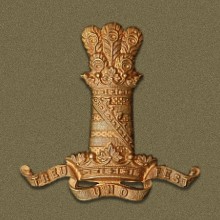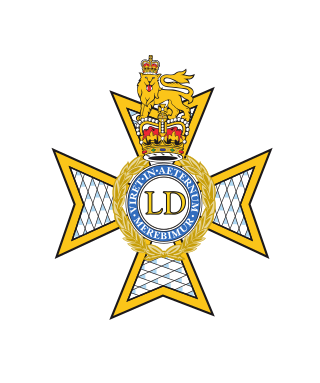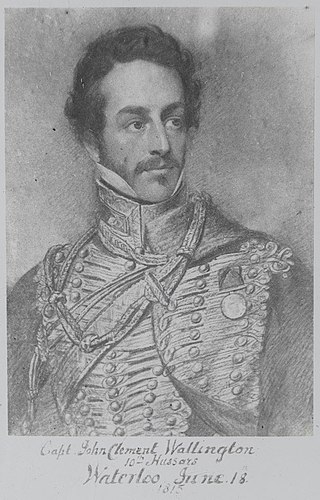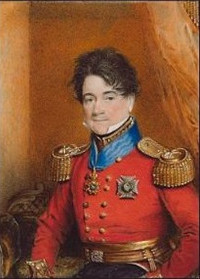Related Research Articles

The 11th Hussars (Prince Albert's Own) was a cavalry regiment of the British Army established in 1715. It saw service for three centuries including the First World War and Second World War but then amalgamated with the 10th Royal Hussars (Prince of Wales' Own) to form the Royal Hussars in 1969.
Clement Walker Heneage, VC was a British Army officer and a recipient of the Victoria Cross, the highest award for gallantry in the face of the enemy that can be awarded to British and Commonwealth forces.

The Light Dragoons (LD) is a cavalry regiment in the British Army. The regiment has a light cavalry role and specialises in mounted and dismounted reconnaissance. The Light Dragoons recruit mainly in Northern England, from County Durham, Northumberland, Tyne and Wear, South Yorkshire and the East Riding of Yorkshire. For this reason, the regiment is known as "England's Northern Cavalry". It is currently based in Catterick Garrison, North Yorkshire.

The 10th Royal Hussars (Prince of Wales's Own) was a cavalry regiment of the British Army raised in 1715. It saw service for three centuries including the First World War and Second World War but then amalgamated with the 11th Hussars (Prince Albert's Own) to form the Royal Hussars (Prince of Wales's Own) in October 1969.

The 13th Hussars was a cavalry regiment of the British Army established in 1715. It saw service for three centuries including the Napoleonic Wars, the Crimean War and the First World War but then amalgamated with the 18th Royal Hussars, to form the 13th/18th Royal Hussars in 1922.

The 14th King's Hussars was a cavalry regiment in the British Army, first raised in 1715. It saw service for two centuries, including the First World War, before being amalgamated with the 20th Hussars to form the 14th/20th King's Hussars in 1922.

The 18th Royal Hussars (Queen Mary's Own) was a cavalry regiment of the British Army, first formed in 1759. It saw service for two centuries, including the First World War before being amalgamated with the 13th Hussars to form the 13th/18th Royal Hussars in 1922.

The 7th Queen's Own Hussars was a cavalry regiment in the British Army, first formed in 1689. It saw service for three centuries, including the First World War and the Second World War. The regiment survived the immediate post-war reduction in forces, but following the 1957 Defence White Paper, it was amalgamated with the 3rd The King's Own Hussars, forming the Queen's Own Hussars in 1958.
General Sir John William Floyd, 1st Baronet, was a British cavalry officer.

General Sir William Eliot Peyton, was a British Army officer who served as Military Secretary to the British Expeditionary Force from 1916 to 1918. He was Delhi Herald of Arms Extraordinary at the time of the Delhi Durbar of 1911.
General Sir John "Black Jack" Slade, 1st Baronet, served as a general officer in the British Army during the Peninsular War. Slade was praised in official reports, including by Arthur Wellesley, 1st Duke of Wellington, who also voiced some criticisms of him privately. Slade received an Army Gold Medal, and was honoured three times with the thanks of Parliament. Slade's descendants include two admirals, namely son Sir Adolphus Slade and grandson Sir Edmond Slade. Despite achieving high rank during and after active soldiering, Slade was criticised as a general of cavalry by some contemporaries and historians.

Lieutenant-Colonel John Clement Wallington was an English cricketer and soldier.
Lieutenant General Sir John Colquhoun Grant was a British soldier.

General Sir Charles Cameron Shute was a British army officer and Conservative Party politician.

Lieutenant-General Sir Joseph Thackwell was a British Army officer. He served with the 15th Hussars in the Peninsular War at the Battle of Sahagún in 1808 and the Battle of Vitoria in 1813, and he lost his left arm at the Battle of Waterloo in 1815. He commanded the regiment from 1820 to 1832. He then served in India, commanding the cavalry in the First Anglo-Afghan War of 1838–89, and at the Battle of Sobraon in the First Anglo-Sikh War of 1845–46, and at the Battle of Chillianwala and Battle of Gujrat in the Second Anglo-Sikh War of 1848–9. He also commanded the 3rd The King's Own Dragoons, was colonel of the 16th Lancers, and was appointed Inspector-general of cavalry.
Colonel Sir Thomas Noel Hill KCB KTS was a British Army officer of the Napoleonic Wars who fought at the Battle of Waterloo on 18 June, 1815.
General William Beckwith, KCH was a general in the British Army.

General the Hon. Edward Pyndar Lygon, CB was a senior officer in the British Army and a Member of Parliament.

General Sir Thomas Hawker KCH was a British Army cavalry officer. Hawker began his career in the 11th Light Dragoons in 1795 and fought with them during the 1799 Anglo-Russian invasion of Holland. In 1804, he purchased the rank of major with the 20th Light Dragoons and served with them in Spain during the Peninsular War. He was promoted to command of the regiment in 1808. Hawker served in the force sent to occupy the Republic of Genoa in 1814 and shortly after was promoted to colonel and given command of a light cavalry brigade. Spending some time on half pay after the end of the Napoleonic Wars he returned to active service as lieutenant-colonel of the 13th Light Dragoons. Hawker was in the East Indies between 1822--26 and 1830-36 and was promoted to major-general in 1825. He was appointed a Knight Commander of the Royal Guelphic Order in 1837 and colonel of the 6th Regiment of Dragoon Guards in 1839. Hawker was promoted to the brevet rank of general in 1854.
General William Hampton Parlby was a senior British Army officer, who served in British cavalry regiments in India and the Crimean War.
References
- "Allan Mallinson biblio". FantasticFiction. Retrieved 20 February 2008.